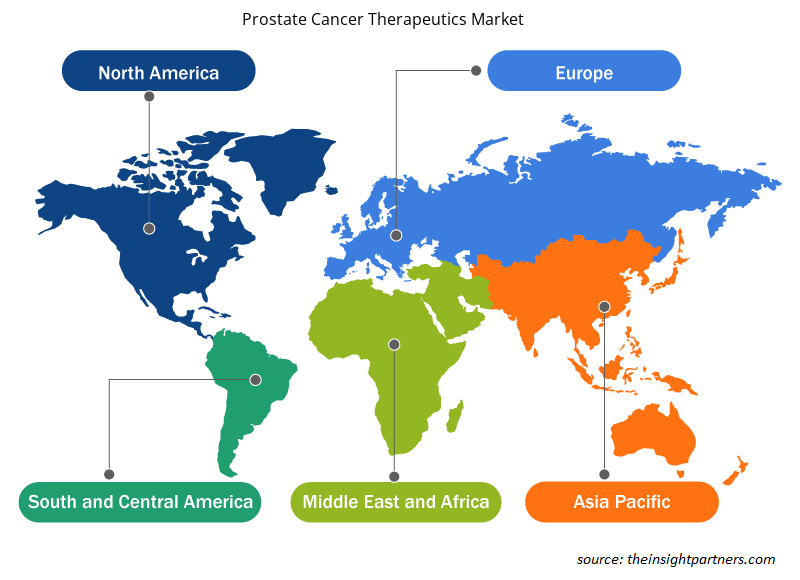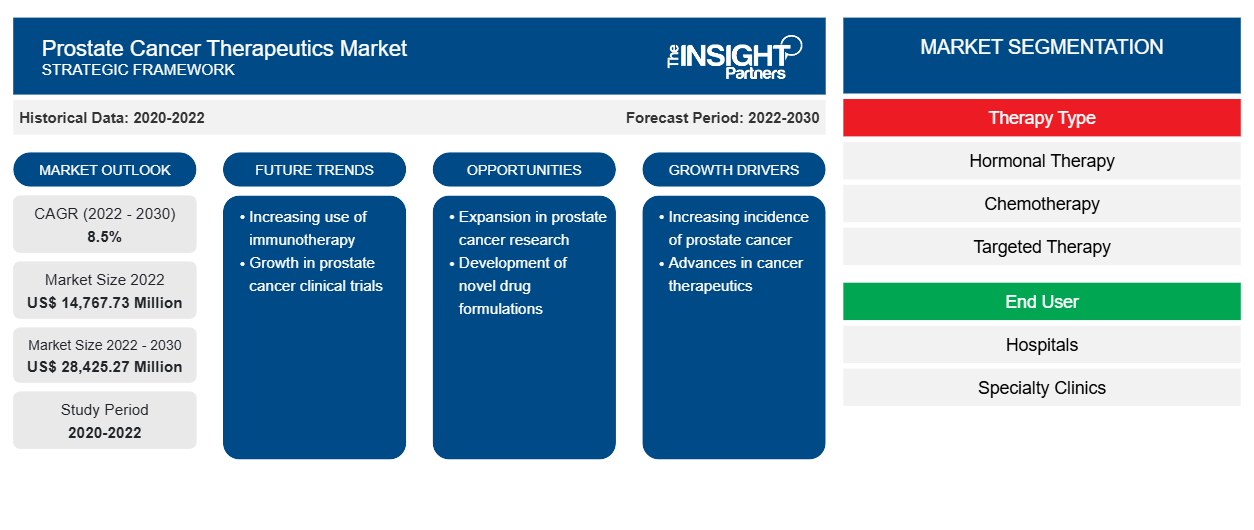[研究报告] 前列腺癌治疗市场预计将从 2022 年的 147.6773 亿美元增长到 2030 年的 284.2527 亿美元;预计 2022 年至 2030 年的复合年增长率为 8.5%。
市场洞察和分析师观点:
随着研发活动不断增加以引入新药物化合物、前列腺癌病例数量不断增加以及政府对前列腺癌诊断的支持不断增加,前列腺癌治疗市场规模正在扩大。此外,市场参与者提供的先进产品推动了市场增长。2023 年 1 月,BDR Pharmaceutical 在印度推出了用于治疗前列腺癌的 Apalutamide 仿制药。该药物以 APATIDE 品牌推出,用于治疗非转移性去势抵抗性前列腺癌和转移性去势敏感性前列腺癌。
增长动力和挑战:
前列腺癌是男性最常见的健康问题之一,尤其是 50 岁及以上的老年男性。前列腺癌最常见于肥胖和有前列腺癌家族史的男性。前列腺癌是一种无声威胁,因为它通常在没有明显症状的情况下发展。因此,早期发现这种癌症并不容易。大多数前列腺癌起源于前列腺的周围区域。症状必须达到对尿道施加压力的大小,或者在某些情况下,转移引起的骨痛可能是晚期前列腺癌的最初症状。但是,任何 50 岁或以上出现下尿路症状、勃起功能障碍或血尿的人都应该考虑前列腺癌的可能性。前列腺癌是全球男性癌症死亡的第五大原因,也是第二大最常见的癌症。虽然自2000年以来前列腺癌的发病率有所下降,但从2010年开始,晚期前列腺癌的发病率有所上升。前列腺癌的发病率和死亡率差异很大。发达国家前列腺癌的发病率普遍较高,但死亡率较低。美国前列腺癌的风险几乎是全球风险的四倍。据诺华公司称,2020年,全球报告了约140万例前列腺癌新病例和约37.5万例前列腺癌死亡病例。全球前列腺癌病例的增加和前列腺癌的低检出率推动了前列腺癌治疗市场的增长。
定制此报告以满足您的需求
您可以免费定制任何报告,包括本报告的部分内容、国家级分析、Excel 数据包,以及为初创企业和大学提供优惠和折扣
- 获取此报告的关键市场趋势。这个免费样品将包括数据分析,从市场趋势到估计和预测。
报告细分和范围:
前列腺癌治疗市场根据治疗类型、最终用户和地理位置进行细分。前列腺癌治疗市场按治疗类型细分为激素治疗、化疗、免疫治疗、靶向治疗和其他。前列腺癌治疗市场按最终用户细分为医院、专科诊所和其他。根据地理位置,前列腺癌治疗市场细分为北美(美国、加拿大和墨西哥)、欧洲(英国、德国、法国、意大利、西班牙和欧洲其他地区)、亚太地区(中国、日本、印度、韩国、澳大利亚和亚太其他地区)、中东和非洲(阿联酋、沙特阿拉伯、南非和中东和非洲其他地区)以及南美洲和中美洲(巴西、阿根廷和南美洲和中美洲其他地区)。
节段分析:
按治疗类型划分,前列腺癌治疗市场细分为激素治疗、化疗、免疫治疗、靶向治疗等。2022 年,激素治疗细分市场在化疗之后占据了最大的市场份额,预计同一细分市场将在 2022 年至 2030 年期间录得最高复合年增长率。化疗被认为是前列腺癌的重要治疗方法。在这种疗法中,药物会破坏肺部新的或现有的癌细胞。转移性前列腺癌的化疗可以缓解症状。它还可以帮助减少癌症并改善生活质量。多西他赛 (Taxotere) 被认为是对激素治疗有抵抗力的前列腺癌化疗患者的标准治疗方法。FDA 还批准了化疗药物卡巴他赛 (Jevtana) 用于治疗去势抵抗性前列腺癌。它也用于在服用多西他赛期间生长的转移性前列腺癌患者。
区域分析:
前列腺癌治疗市场按地理区域划分为北美、欧洲、亚太地区、中东和非洲以及南美和中美洲。北美是全球前列腺癌治疗市场增长的最大贡献者。预计亚太地区将在 2022 年至 2030 年期间实现前列腺癌治疗市场的最高复合年增长率。美国前列腺癌治疗市场的增长主要受前列腺癌病例发病率增加、产品推出和政府举措的推动。2023 年 6 月,阿斯利康和默沙东的 Lynparza (olaparib) 与泼尼松或泼尼松龙和阿比特龙联合用药在美国获得批准,用于治疗疑似有害 BRCA 突变 (BRCAm) 转移性去势抵抗性前列腺癌 (mCRPC) 的成年患者。此外,2023 年 11 月,FDA 批准了由 Astellas Pharma US, Inc. 生产的产品恩杂鲁胺。该产品用于治疗生化复发且转移风险高(高危BCR)的非转移性去势敏感性前列腺癌(nmCSPC)。
前列腺癌治疗市场区域洞察
Insight Partners 的分析师已详尽解释了预测期内影响前列腺癌治疗市场的区域趋势和因素。本节还讨论了北美、欧洲、亚太地区、中东和非洲以及南美和中美洲的前列腺癌治疗市场细分和地理位置。

- 获取前列腺癌治疗市场的区域特定数据
前列腺癌治疗市场报告范围
| 报告属性 | 细节 |
|---|---|
| 2022 年市场规模 | 147.6773亿美元 |
| 2030 年市场规模 | 284.2527亿美元 |
| 全球复合年增长率(2022 - 2030 年) | 8.5% |
| 史料 | 2020-2022 |
| 预测期 | 2022-2030 |
| 涵盖的领域 | 按治疗类型
|
| 覆盖地区和国家 | 北美
|
| 市场领导者和主要公司简介 |
|
市场参与者密度:了解其对商业动态的影响
前列腺癌治疗市场正在快速增长,这得益于终端用户需求的不断增长,而这些需求又源于消费者偏好的不断变化、技术进步以及对产品优势的认识不断提高等因素。随着需求的增加,企业正在扩大其产品范围,进行创新以满足消费者的需求,并利用新兴趋势,从而进一步推动市场增长。
市场参与者密度是指在特定市场或行业内运营的企业或公司的分布情况。它表明在给定市场空间中,相对于其规模或总市场价值,有多少竞争对手(市场参与者)存在。
在前列腺癌治疗市场运营的主要公司有:
- 安斯泰拉制药公司
- 强生服务公司
- 礼来公司
- 拜耳公司
- 赛诺菲
免责声明:上面列出的公司没有按照任何特定顺序排列。

- 了解前列腺癌治疗市场顶级关键参与者概况
行业发展和未来机遇:
以下列出了前列腺癌治疗市场主要参与者的各种举措:
- 2022年3月,美国FDA批准了诺华的Pluvicto(lutetium Lu 177 vipivotide tetraxetan),用于治疗一种称为前列腺特异性膜抗原阳性转移性去势抵抗性前列腺癌(PSMA阳性mCRPC)的晚期前列腺癌成年患者。
- 2023 年 4 月,FDA 授予 Lantheus Holdings Inc 和 POINT Biopharma Global Inc 177Lu-PNT2002 快速通道资格,用于治疗转移性去势抵抗性前列腺癌 (mCRPC)。PNT2002 是一种创新的 PSMA 靶向 177Lu 放射性药物疗法,结合了 PSMA 靶向配体、PSMA-I&T 和无载体添加的 β 发射放射性同位素 177Lu,用于治疗 mCRPC。
竞争格局和重点公司:
安斯泰拉制药公司、强生服务公司、礼来公司、拜耳公司、赛诺菲、默克集团、阿斯利康、诺华公司、艾伯维和百时美施贵宝是前列腺癌治疗市场的主要参与者。这些市场参与者专注于新产品的推出和地域扩张,以满足全球日益增长的消费者需求,并增加其专业产品组合的产品范围。他们的全球影响力使他们能够服务于庞大的客户群,从而促进市场扩张。
- 历史分析(2 年)、基准年、预测(7 年)及复合年增长率
- PEST 和 SWOT 分析
- 市场规模价值/数量 - 全球、区域、国家
- 行业和竞争格局
- Excel 数据集


- Single-Use Negative Pressure Wound Therapy Devices Market
- Authentication and Brand Protection Market
- Malaria Treatment Market
- Travel Vaccines Market
- Digital Pathology Market
- GMP Cytokines Market
- Long Read Sequencing Market
- Enzymatic DNA Synthesis Market
- Legal Case Management Software Market
- Europe Industrial Chillers Market

Report Coverage
Revenue forecast, Company Analysis, Industry landscape, Growth factors, and Trends

Segment Covered
This text is related
to segments covered.

Regional Scope
North America, Europe, Asia Pacific, Middle East & Africa, South & Central America

Country Scope
This text is related
to country scope.
常见问题
Based on geography, the prostate cancer therapeutics market is segmented into North America (the US, Canada, and Mexico), Europe (the UK, Germany, France, Italy, Spain, and the Rest of Europe), Asia Pacific (China, Japan, India, South Korea, Australia, and the Rest of Asia Pacific), the Middle East & Africa (the UAE, Saudi Arabia, South Africa, and Rest of the Middle East & Africa), and South & Central America (Brazil, Argentina, and the Rest of South & Central America). North America is the largest contributor to global prostate cancer therapeutics market growth. Asia Pacific is expected to register the highest CAGR in the prostate cancer therapeutics market from 2022 to 2030.
The prostate cancer therapeutics market, by therapy type, is segmented into hormone therapy, chemotherapy, immunotherapy, targeted therapy, and others. In 2022, the chemotherapy segment held the largest market share, and the same segment is expected to record the highest CAGR from 2022 to 2030.
The prostate cancer therapeutics market, by end-user, is segmented into hospitals, specialty clinics, and others. In 2022, the hospital segment held the largest market share; moreover, the same segment is expected to record the highest CAGR during 2022–2030.
The increasing cases of prostate cancer and strategic initiatives in prostate cancer therapeutics freezer bolster the prostate cancer therapeutics market size. However, the high cost associated with prostate cancer therapeutics hinders the growth of prostate cancer therapeutics market growth.
The prostate cancer therapeutics market majorly consists of players such Astella Pharma Inc, Johnson & Johnson Services Inc, Eli Lilly and Company, Bayer AG, Sanofi, Merck KGaA, AstraZeneca, Novartis AG, AbbVie, and Bristol Myers Squibb
Prostate cancer is one of the most common health problems in men, especially in older men (aged above 50 years). Prostate cancer is mostly common in men who are obese and have a family history of prostate cancer. Prostate cancer is a silent threat that often develops without noticeable symptoms, and hence, early detection of this cancer is not that easy. Typically, the majority of prostate cancers originate in the peripheral region of the prostate gland. Consequently, for symptoms to become apparent, the cancer must reach a size where it exerts pressure on the urethra, or in some cases, bone pain from the metastasis might be the initial presenting symptom of advanced prostate cancer. However, any individual aged 50 or above who presents with lower urinary tract symptoms, erectile dysfunction, or hematuria should consider the possibility of prostate cancer.
Trends and growth analysis reports related to Life Sciences : READ MORE..
The List of Companies - Prostate Cancer Market
- Astella Pharma Inc
- Johnson & Johnson Services Inc
- Eli Lilly, and Company
- Bayer AG
- Sanofi
- Merck KGaA
- AstraZeneca
- Novartis AG
- AbbVie
- Bristol Myers Squibb
The Insight Partners performs research in 4 major stages: Data Collection & Secondary Research, Primary Research, Data Analysis and Data Triangulation & Final Review.
- Data Collection and Secondary Research:
As a market research and consulting firm operating from a decade, we have published and advised several client across the globe. First step for any study will start with an assessment of currently available data and insights from existing reports. Further, historical and current market information is collected from Investor Presentations, Annual Reports, SEC Filings, etc., and other information related to company’s performance and market positioning are gathered from Paid Databases (Factiva, Hoovers, and Reuters) and various other publications available in public domain.
Several associations trade associates, technical forums, institutes, societies and organization are accessed to gain technical as well as market related insights through their publications such as research papers, blogs and press releases related to the studies are referred to get cues about the market. Further, white papers, journals, magazines, and other news articles published in last 3 years are scrutinized and analyzed to understand the current market trends.
- Primary Research:
The primarily interview analysis comprise of data obtained from industry participants interview and answers to survey questions gathered by in-house primary team.
For primary research, interviews are conducted with industry experts/CEOs/Marketing Managers/VPs/Subject Matter Experts from both demand and supply side to get a 360-degree view of the market. The primary team conducts several interviews based on the complexity of the markets to understand the various market trends and dynamics which makes research more credible and precise.
A typical research interview fulfils the following functions:
- Provides first-hand information on the market size, market trends, growth trends, competitive landscape, and outlook
- Validates and strengthens in-house secondary research findings
- Develops the analysis team’s expertise and market understanding
Primary research involves email interactions and telephone interviews for each market, category, segment, and sub-segment across geographies. The participants who typically take part in such a process include, but are not limited to:
- Industry participants: VPs, business development managers, market intelligence managers and national sales managers
- Outside experts: Valuation experts, research analysts and key opinion leaders specializing in the electronics and semiconductor industry.
Below is the breakup of our primary respondents by company, designation, and region:

Once we receive the confirmation from primary research sources or primary respondents, we finalize the base year market estimation and forecast the data as per the macroeconomic and microeconomic factors assessed during data collection.
- Data Analysis:
Once data is validated through both secondary as well as primary respondents, we finalize the market estimations by hypothesis formulation and factor analysis at regional and country level.
- Macro-Economic Factor Analysis:
We analyse macroeconomic indicators such the gross domestic product (GDP), increase in the demand for goods and services across industries, technological advancement, regional economic growth, governmental policies, the influence of COVID-19, PEST analysis, and other aspects. This analysis aids in setting benchmarks for various nations/regions and approximating market splits. Additionally, the general trend of the aforementioned components aid in determining the market's development possibilities.
- Country Level Data:
Various factors that are especially aligned to the country are taken into account to determine the market size for a certain area and country, including the presence of vendors, such as headquarters and offices, the country's GDP, demand patterns, and industry growth. To comprehend the market dynamics for the nation, a number of growth variables, inhibitors, application areas, and current market trends are researched. The aforementioned elements aid in determining the country's overall market's growth potential.
- Company Profile:
The “Table of Contents” is formulated by listing and analyzing more than 25 - 30 companies operating in the market ecosystem across geographies. However, we profile only 10 companies as a standard practice in our syndicate reports. These 10 companies comprise leading, emerging, and regional players. Nonetheless, our analysis is not restricted to the 10 listed companies, we also analyze other companies present in the market to develop a holistic view and understand the prevailing trends. The “Company Profiles” section in the report covers key facts, business description, products & services, financial information, SWOT analysis, and key developments. The financial information presented is extracted from the annual reports and official documents of the publicly listed companies. Upon collecting the information for the sections of respective companies, we verify them via various primary sources and then compile the data in respective company profiles. The company level information helps us in deriving the base number as well as in forecasting the market size.
- Developing Base Number:
Aggregation of sales statistics (2020-2022) and macro-economic factor, and other secondary and primary research insights are utilized to arrive at base number and related market shares for 2022. The data gaps are identified in this step and relevant market data is analyzed, collected from paid primary interviews or databases. On finalizing the base year market size, forecasts are developed on the basis of macro-economic, industry and market growth factors and company level analysis.
- Data Triangulation and Final Review:
The market findings and base year market size calculations are validated from supply as well as demand side. Demand side validations are based on macro-economic factor analysis and benchmarks for respective regions and countries. In case of supply side validations, revenues of major companies are estimated (in case not available) based on industry benchmark, approximate number of employees, product portfolio, and primary interviews revenues are gathered. Further revenue from target product/service segment is assessed to avoid overshooting of market statistics. In case of heavy deviations between supply and demand side values, all thes steps are repeated to achieve synchronization.
We follow an iterative model, wherein we share our research findings with Subject Matter Experts (SME’s) and Key Opinion Leaders (KOLs) until consensus view of the market is not formulated – this model negates any drastic deviation in the opinions of experts. Only validated and universally acceptable research findings are quoted in our reports.
We have important check points that we use to validate our research findings – which we call – data triangulation, where we validate the information, we generate from secondary sources with primary interviews and then we re-validate with our internal data bases and Subject matter experts. This comprehensive model enables us to deliver high quality, reliable data in shortest possible time.


 获取此报告的免费样本
获取此报告的免费样本